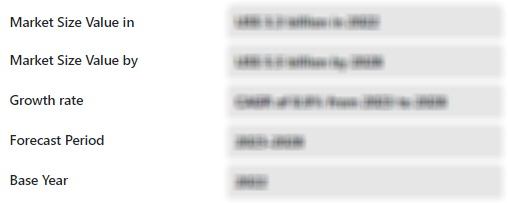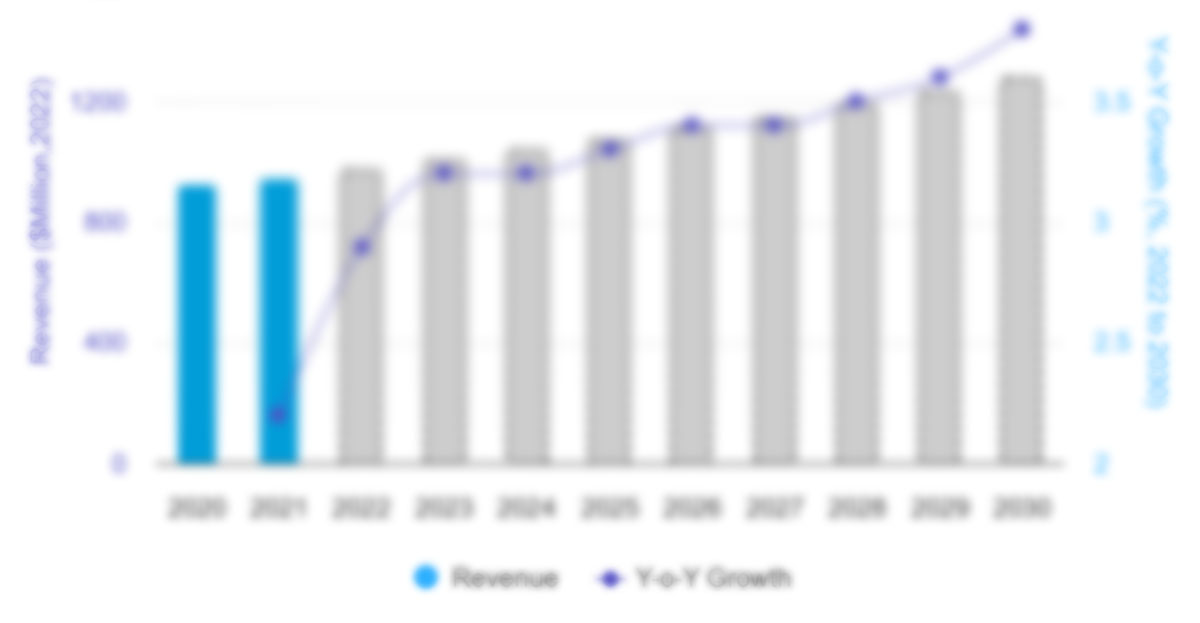The Pediatric Radiology Market is expected to register a CAGR of 4.5% from 2025 to 2031, with a market size expanding from US$ XX million in 2024 to US$ XX Million by 2031.
The report is segmented by Product Type (Ultrasound, MRI, X-Ray and Computed Tomography Scanner, and Other Product Types). The report further presents analysis based on the End User (Medical and Healthcare, Manufacturing Industry, and Other End Users). The global analysis is further broken-down at regional level and major countries. The Report Offers the Value in USD for the above analysis and segments.
Purpose of the ReportThe report Pediatric Radiology Market by The Insight Partners aims to describe the present landscape and future growth, top driving factors, challenges, and opportunities. This will provide insights to various business stakeholders, such as:
- Technology Providers/Manufacturers: To understand the evolving market dynamics and know the potential growth opportunities, enabling them to make informed strategic decisions.
- Investors: To conduct a comprehensive trend analysis regarding the market growth rate, market financial projections, and opportunities that exist across the value chain.
- Regulatory bodies: To regulate policies and police activities in the market with the aim of minimizing abuse, preserving investor trust and confidence, and upholding the integrity and stability of the market.
Pediatric Radiology Market Segmentation
Product Type- Ultrasound
- MRI
- X-Ray and Computed Tomography Scanner
- Other Product Types
- Standalone Devices
- Table-Top Devices
- Portable Devices
- Pediatric Clinics
- Diagnostic Centers
- Hospitals
- Other End Users
Strategic Insights
Pediatric Radiology Market Growth Drivers- Increasing Prevalence of Pediatric Disorders: The rising incidence of pediatric diseases, including congenital conditions, cancers, and respiratory disorders, is driving the demand for pediatric radiology services. Early diagnosis through advanced imaging techniques helps in timely intervention and treatment, fueling the market for pediatric radiology devices and services.
- Technological Advancements in Imaging: The development of non-invasive, high-resolution imaging techniques such as MRI, CT, and ultrasound is revolutionizing pediatric radiology. These advancements enable better imaging results while minimizing radiation exposure to children. This trend is promoting the adoption of pediatric radiology services and devices across healthcare facilities.
- Growing Focus on Pediatric Healthcare: The global increase in healthcare spending and growing awareness about pediatric care is encouraging investments in pediatric radiology. With improved healthcare infrastructure in both developed and emerging markets, the demand for specialized pediatric radiology services is increasing, contributing to market growth.
- Miniaturization of Imaging Devices: Pediatric patients require specially designed imaging devices that are compact and child-friendly. The trend toward miniaturization is making imaging devices more suitable for young patients, improving patient comfort and ease of use. These devices are also designed to reduce radiation exposure, making them safer for pediatric use.
- Increased Use of MRI for Pediatric Imaging: Magnetic Resonance Imaging (MRI) is becoming the preferred imaging method for pediatric radiology due to its non-invasive nature and ability to produce high-quality images without ionizing radiation. The growing shift toward MRI systems in pediatric diagnostics is a key trend in the market, driven by safety concerns and better diagnostic accuracy.
- Telemedicine and Remote Diagnostics: Telemedicine is increasingly being integrated into pediatric radiology services, allowing radiologists to remotely analyze imaging results and provide consultations. This trend is helping improve access to pediatric radiology services, particularly in underserved areas, by enabling remote diagnosis and expert reviews.
- Growing Demand in Emerging Markets: Emerging economies are seeing a surge in pediatric healthcare demand, including radiology services. With the rise in disposable income and healthcare access in these regions, there is a significant opportunity for companies to expand their pediatric radiology offerings and improve access to advanced diagnostic services for children.
- Government Initiatives for Pediatric Health: Government programs aimed at improving pediatric healthcare access, such as vaccination programs and specialized diagnostic facilities, present an opportunity for growth in the pediatric radiology market. Partnerships with governments and NGOs in developing countries can open up new avenues for market players.
- Innovative Imaging Solutions for Children: There is an opportunity to develop innovative, non-invasive imaging solutions specifically designed for children. Market players can invest in child-friendly devices, low-radiation imaging techniques, and solutions that improve patient experience to cater to this growing niche market.
Market Report Scope
Key Selling Points
- Comprehensive Coverage: The report comprehensively covers the analysis of products, services, types, and end users of the Pediatric Radiology Market, providing a holistic landscape.
- Expert Analysis: The report is compiled based on the in-depth understanding of industry experts and analysts.
- Up-to-date Information: The report assures business relevance due to its coverage of recent information and data trends.
- Customization Options: This report can be customized to cater to specific client requirements and suit the business strategies aptly.
The research report on the Pediatric Radiology Market can, therefore, help spearhead the trail of decoding and understanding the industry scenario and growth prospects. Although there can be a few valid concerns, the overall benefits of this report tend to outweigh the disadvantages.
REGIONAL FRAMEWORK
Have a question?

Mrinal
Mrinal will walk you through a 15-minute call to present the report’s content and answer all queries if you have any.
 Speak to Analyst
Speak to Analyst
- Sample PDF showcases the content structure and the nature of the information with qualitative and quantitative analysis.
- Request discounts available for Start-Ups & Universities
- Sample PDF showcases the content structure and the nature of the information with qualitative and quantitative analysis.
- Request discounts available for Start-Ups & Universities

Report Coverage
Revenue forecast, Company Analysis, Industry landscape, Growth factors, and Trends

Segment Covered
This text is related
to segments covered.

Regional Scope
North America, Europe, Asia Pacific, Middle East & Africa, South & Central America

Country Scope
This text is related
to country scope.
Frequently Asked Questions
Increasing pediatric disorder prevalence, technological advancements in imaging, and a growing focus on pediatric healthcare are key drivers.
Advancements in imaging technology, including MRI and CT scans, are enhancing diagnostic accuracy while minimizing radiation exposure to children.
Challenges include the high cost of equipment, the need for specialized training, and concerns over radiation exposure during imaging procedures.
Miniaturization of devices, increased use of MRI, and integration of telemedicine are driving key trends in the market.
Emerging markets, government initiatives, and innovation in child-friendly imaging solutions offer substantial growth opportunities.
Key concerns include radiation safety, accessibility to advanced radiology equipment, and ensuring appropriate training for pediatric radiologists
- GE Healthcare
- Siemens Healthineers
- Philips Healthcare
- Canon Medical Systems
- Toshiba Medical Systems
- Hitachi Medical Corporation
- Fujifilm
- Carestream Health
- Samsung Medison
- Hologic
The Insight Partners performs research in 4 major stages: Data Collection & Secondary Research, Primary Research, Data Analysis and Data Triangulation & Final Review.
- Data Collection and Secondary Research:
As a market research and consulting firm operating from a decade, we have published many reports and advised several clients across the globe. First step for any study will start with an assessment of currently available data and insights from existing reports. Further, historical and current market information is collected from Investor Presentations, Annual Reports, SEC Filings, etc., and other information related to company’s performance and market positioning are gathered from Paid Databases (Factiva, Hoovers, and Reuters) and various other publications available in public domain.
Several associations trade associates, technical forums, institutes, societies and organizations are accessed to gain technical as well as market related insights through their publications such as research papers, blogs and press releases related to the studies are referred to get cues about the market. Further, white papers, journals, magazines, and other news articles published in the last 3 years are scrutinized and analyzed to understand the current market trends.
- Primary Research:
The primarily interview analysis comprise of data obtained from industry participants interview and answers to survey questions gathered by in-house primary team.
For primary research, interviews are conducted with industry experts/CEOs/Marketing Managers/Sales Managers/VPs/Subject Matter Experts from both demand and supply side to get a 360-degree view of the market. The primary team conducts several interviews based on the complexity of the markets to understand the various market trends and dynamics which makes research more credible and precise.
A typical research interview fulfils the following functions:
- Provides first-hand information on the market size, market trends, growth trends, competitive landscape, and outlook
- Validates and strengthens in-house secondary research findings
- Develops the analysis team’s expertise and market understanding
Primary research involves email interactions and telephone interviews for each market, category, segment, and sub-segment across geographies. The participants who typically take part in such a process include, but are not limited to:
- Industry participants: VPs, business development managers, market intelligence managers and national sales managers
- Outside experts: Valuation experts, research analysts and key opinion leaders specializing in the electronics and semiconductor industry.
Below is the breakup of our primary respondents by company, designation, and region:

Once we receive the confirmation from primary research sources or primary respondents, we finalize the base year market estimation and forecast the data as per the macroeconomic and microeconomic factors assessed during data collection.
- Data Analysis:
Once data is validated through both secondary as well as primary respondents, we finalize the market estimations by hypothesis formulation and factor analysis at regional and country level.
- 3.1 Macro-Economic Factor Analysis:
We analyse macroeconomic indicators such the gross domestic product (GDP), increase in the demand for goods and services across industries, technological advancement, regional economic growth, governmental policies, the influence of COVID-19, PEST analysis, and other aspects. This analysis aids in setting benchmarks for various nations/regions and approximating market splits. Additionally, the general trend of the aforementioned components aid in determining the market's development possibilities.
- 3.2 Country Level Data:
Various factors that are especially aligned to the country are taken into account to determine the market size for a certain area and country, including the presence of vendors, such as headquarters and offices, the country's GDP, demand patterns, and industry growth. To comprehend the market dynamics for the nation, a number of growth variables, inhibitors, application areas, and current market trends are researched. The aforementioned elements aid in determining the country's overall market's growth potential.
- 3.3 Company Profile:
The “Table of Contents” is formulated by listing and analyzing more than 25 - 30 companies operating in the market ecosystem across geographies. However, we profile only 10 companies as a standard practice in our syndicate reports. These 10 companies comprise leading, emerging, and regional players. Nonetheless, our analysis is not restricted to the 10 listed companies, we also analyze other companies present in the market to develop a holistic view and understand the prevailing trends. The “Company Profiles” section in the report covers key facts, business description, products & services, financial information, SWOT analysis, and key developments. The financial information presented is extracted from the annual reports and official documents of the publicly listed companies. Upon collecting the information for the sections of respective companies, we verify them via various primary sources and then compile the data in respective company profiles. The company level information helps us in deriving the base number as well as in forecasting the market size.
- 3.4 Developing Base Number:
Aggregation of sales statistics (2020-2022) and macro-economic factor, and other secondary and primary research insights are utilized to arrive at base number and related market shares for 2022. The data gaps are identified in this step and relevant market data is analyzed, collected from paid primary interviews or databases. On finalizing the base year market size, forecasts are developed on the basis of macro-economic, industry and market growth factors and company level analysis.
- Data Triangulation and Final Review:
The market findings and base year market size calculations are validated from supply as well as demand side. Demand side validations are based on macro-economic factor analysis and benchmarks for respective regions and countries. In case of supply side validations, revenues of major companies are estimated (in case not available) based on industry benchmark, approximate number of employees, product portfolio, and primary interviews revenues are gathered. Further revenue from target product/service segment is assessed to avoid overshooting of market statistics. In case of heavy deviations between supply and demand side values, all thes steps are repeated to achieve synchronization.
We follow an iterative model, wherein we share our research findings with Subject Matter Experts (SME’s) and Key Opinion Leaders (KOLs) until consensus view of the market is not formulated – this model negates any drastic deviation in the opinions of experts. Only validated and universally acceptable research findings are quoted in our reports.
We have important check points that we use to validate our research findings – which we call – data triangulation, where we validate the information, we generate from secondary sources with primary interviews and then we re-validate with our internal data bases and Subject matter experts. This comprehensive model enables us to deliver high quality, reliable data in shortest possible time.





 Get Free Sample For
Get Free Sample For